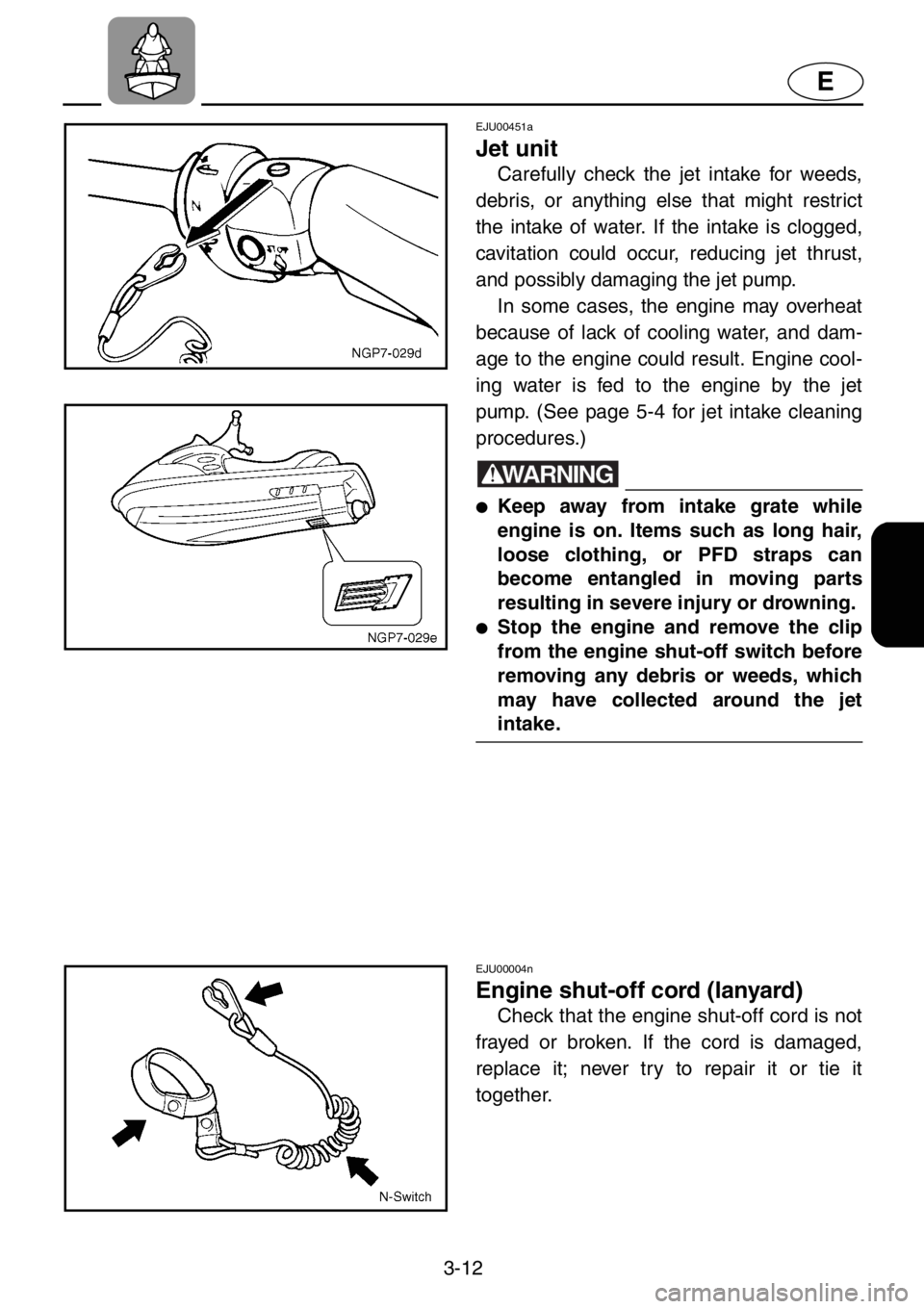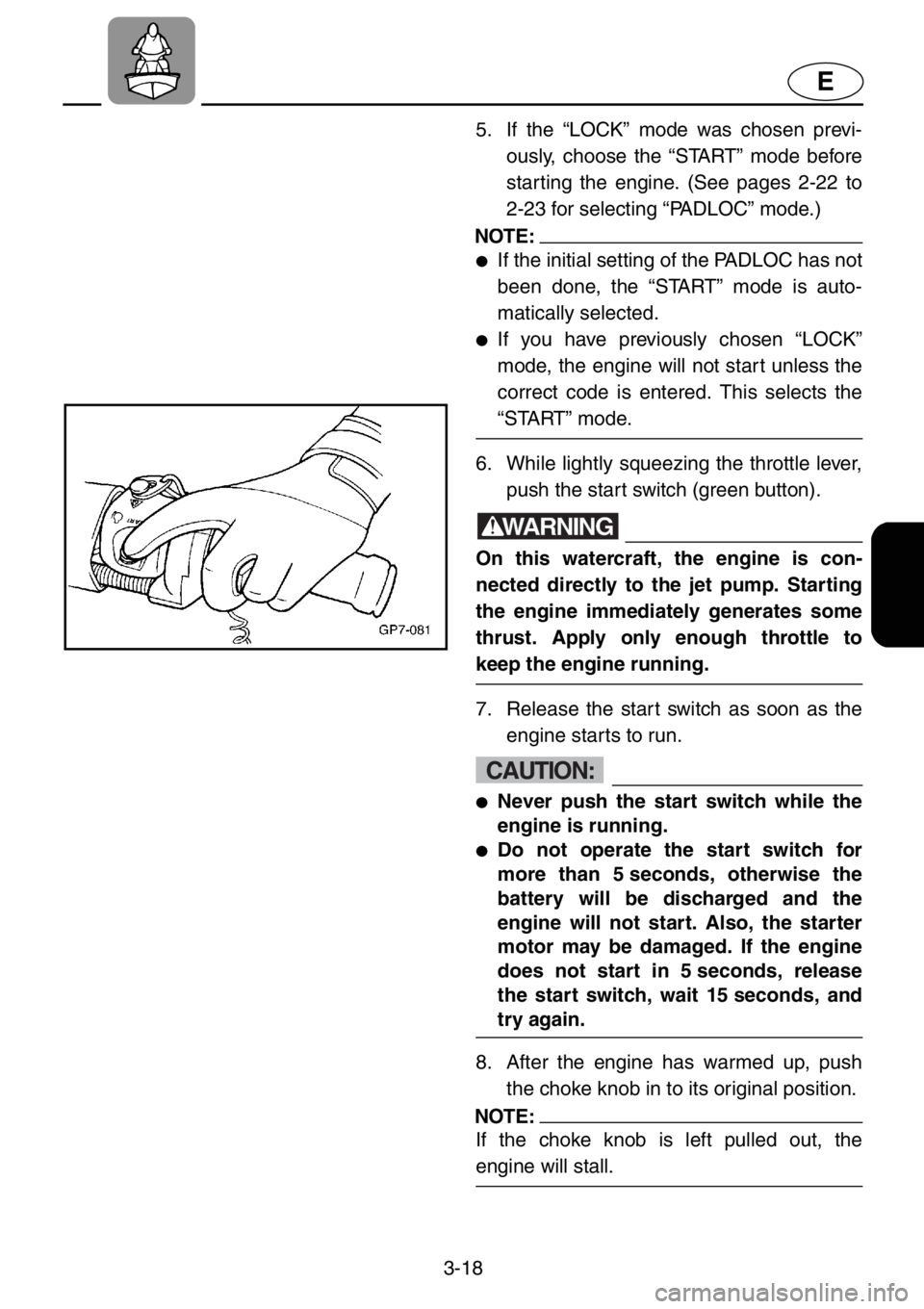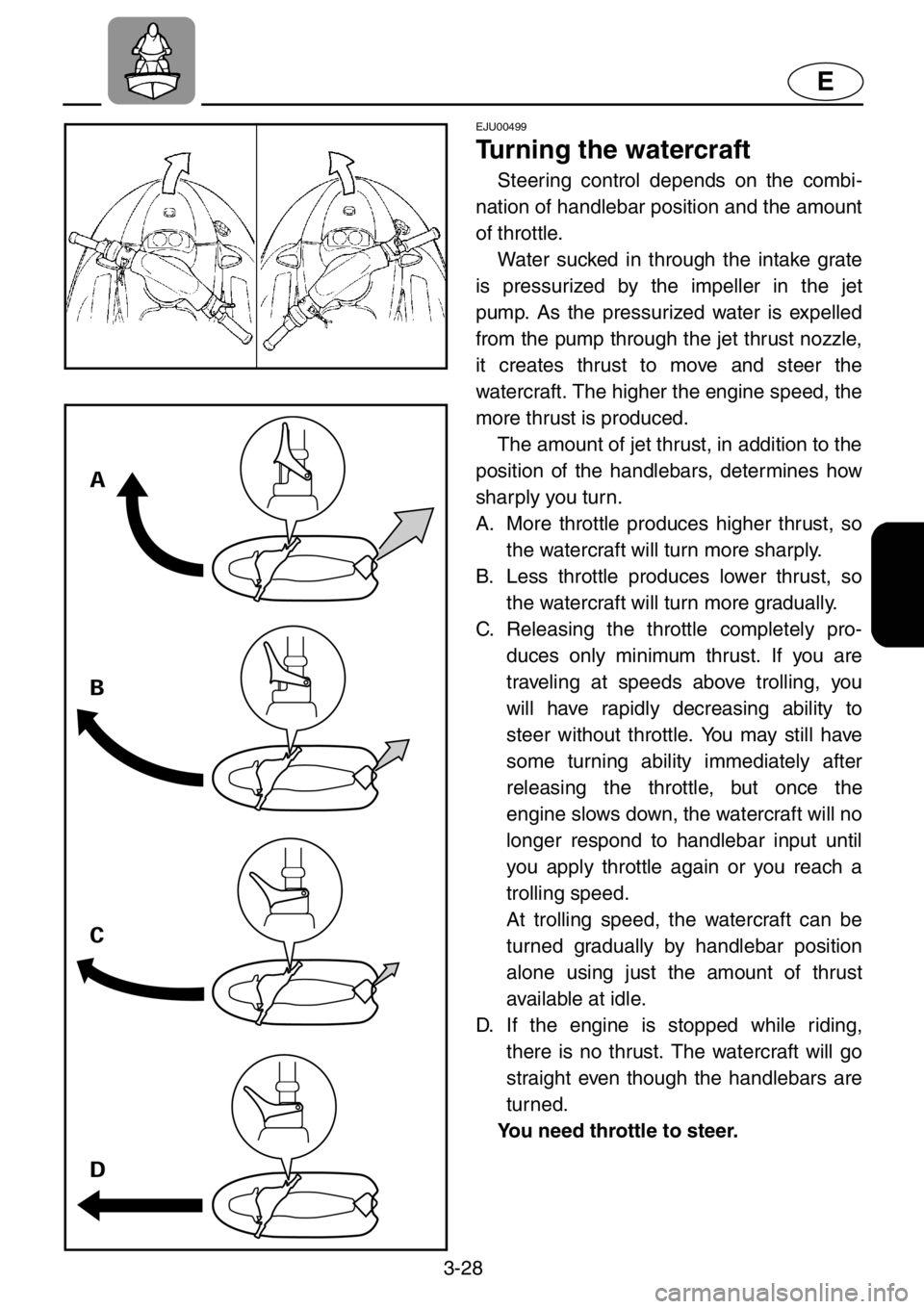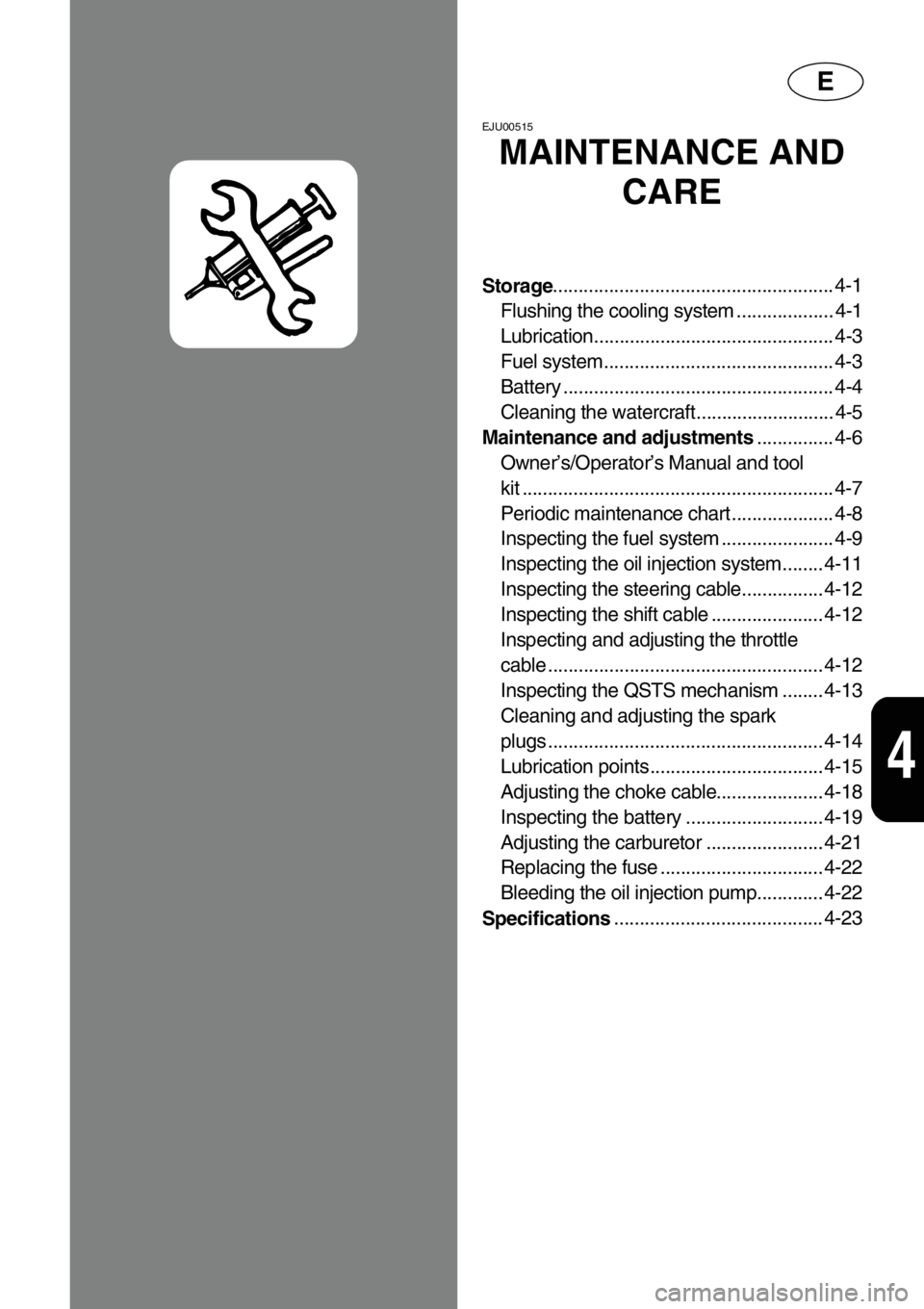Page 20 of 131

1-13
E
EJU00315a
Watercraft characteristics
●Jet thrust turns the watercraft. Releasing
the throttle completely produces only min-
imum thrust. If you are traveling at speeds
above trolling, you will have rapidly
decreasing ability to steer without throttle.
You may still have some turning ability
immediately after releasing the throttle,
but once the engine slows down, the
watercraft will no longer respond to han-
dlebar input until you open the throttle
again or you reach a trolling speed. Prac-
tice turning in an open area without
obstructions until you have a good feel for
this maneuver.
●This watercraft are water-jet propelled.
The jet pump is directly connected to the
engine. This means that jet thrust will pro-
duce some movement whenever the
engine is running. There is no “neutral”
position. You are in either “forward” or
“reverse,” depending upon the shift lever
position.
●Do not use the reverse function to slow
down or stop the watercraft as it could
cause you to lose control, be ejected, or
impact the handlebars.
This could increase the risk of back/spinal
injury (paralysis), facial injuries, and bro-
ken legs, ankles, and other bones. You
could also damage the shift mechanism.
●Reverse can be used to slow down or
stop during slow speed maneuvering,
such as when docking. Once the engine
is idling, shift to reverse and gradually
increase engine speed. Make sure that
there are no obstacles or people behind
you before shifting into reverse.
●Keep away from intake grate 1 while the
engine is on. Items such as long hair,
loose clothing, or PFD straps can become
entangled in moving parts resulting in
severe injury or drowning.
●Never insert any object into the jet thrust
nozzle 2 while the engine is running.
Severe injury or death could result from
coming in contact with the rotating parts
of the jet pump.
●Stop the engine and remove the clip 3
from the engine shut-off switch 4 before
removing any debris or weeds, which may
have collected around the jet intake.
Page 27 of 131
2-2
E
1Fuel tank filler cap
2Rope holes
3Intake grate
Prevents debris from getting into the jet pump.
4Speed sensor
5Cleat
Use to attach a towrope for pulling water-skier,
or a rope for mooring the watercraft.
6Handgrip
Use for support when boarding the watercraft
or when seated facing rearward and acting as
a spotter for a water-skier.7Reverse gate
Controls direction of jet thrust when in reverse.
8Stern drain plugs
Use to drain water in the bilge when the water-
craft is on dry land.
9Jet thrust nozzle
Changes the direction of jet thrust according
to handlebar position.
0Ride plate
Page 42 of 131

2-17
E
EJU00366
Engine overheat warning
system
The model has an overheat warning
device. If the engine starts to overheat, the
warning light, indicator and “W.TEMP” on
the meter begin to blink and the buzzer
sounds intermittently. If this happens,
reduce the engine speed and return to
beach at low speed. If there is no water dis-
charge at the cooling water pilot outlet while
the engine is running, check the jet intake
and impeller for clogging.
WARNING
Before attempting to remove weeds or
debris from the intake grate or impeller,
shut the engine off and remove the clip
from the engine shut-off switch. Severe
injury or death could result from coming
in contact with the rotating parts of the
jet pump.
CAUTION:
●Return to shore at low speed if the
overheat warning indicator and buzzer
are on, and the display shows
“W.TEMP.” If you ignore these signals,
the engine will stop running and can-
not be restarted until the exhaust sys-
tem cools.
●Have your watercraft inspected and
serviced by a Yamaha dealer if the
engine stopped due to overheating.
Page 69 of 131

3-12
E
EJU00451a
Jet unit
Carefully check the jet intake for weeds,
debris, or anything else that might restrict
the intake of water. If the intake is clogged,
cavitation could occur, reducing jet thrust,
and possibly damaging the jet pump.
In some cases, the engine may overheat
because of lack of cooling water, and dam-
age to the engine could result. Engine cool-
ing water is fed to the engine by the jet
pump. (See page 5-4 for jet intake cleaning
procedures.)
WARNING
●Keep away from intake grate while
engine is on. Items such as long hair,
loose clothing, or PFD straps can
become entangled in moving parts
resulting in severe injury or drowning.
●Stop the engine and remove the clip
from the engine shut-off switch before
removing any debris or weeds, which
may have collected around the jet
intake.
EJU00004n
Engine shut-off cord (lanyard)
Check that the engine shut-off cord is not
frayed or broken. If the cord is damaged,
replace it; never try to repair it or tie it
together.
Page 75 of 131

3-18
E
5. If the “LOCK” mode was chosen previ-
ously, choose the “START” mode before
starting the engine. (See pages 2-22 to
2-23 for selecting “PADLOC” mode.)
NOTE:
●If the initial setting of the PADLOC has not
been done, the “START” mode is auto-
matically selected.
●If you have previously chosen “LOCK”
mode, the engine will not start unless the
correct code is entered. This selects the
“START” mode.
6. While lightly squeezing the throttle lever,
push the start switch (green button).
WARNING
On this watercraft, the engine is con-
nected directly to the jet pump. Starting
the engine immediately generates some
thrust. Apply only enough throttle to
keep the engine running.
7. Release the start switch as soon as the
engine starts to run.
CAUTION:
●Never push the start switch while the
engine is running.
●Do not operate the start switch for
more than 5 seconds, otherwise the
battery will be discharged and the
engine will not start. Also, the starter
motor may be damaged. If the engine
does not start in 5 seconds, release
the start switch, wait 15 seconds, and
try again.
8. After the engine has warmed up, push
the choke knob in to its original position.
NOTE:
If the choke knob is left pulled out, the
engine will stall.
Page 85 of 131

3-28
E
EJU00499
Turning the watercraft
Steering control depends on the combi-
nation of handlebar position and the amount
of throttle.
Water sucked in through the intake grate
is pressurized by the impeller in the jet
pump. As the pressurized water is expelled
from the pump through the jet thrust nozzle,
it creates thrust to move and steer the
watercraft. The higher the engine speed, the
more thrust is produced.
The amount of jet thrust, in addition to the
position of the handlebars, determines how
sharply you turn.
A. More throttle produces higher thrust, so
the watercraft will turn more sharply.
B. Less throttle produces lower thrust, so
the watercraft will turn more gradually.
C. Releasing the throttle completely pro-
duces only minimum thrust. If you are
traveling at speeds above trolling, you
will have rapidly decreasing ability to
steer without throttle. You may still have
some turning ability immediately after
releasing the throttle, but once the
engine slows down, the watercraft will no
longer respond to handlebar input until
you apply throttle again or you reach a
trolling speed.
At trolling speed, the watercraft can be
turned gradually by handlebar position
alone using just the amount of thrust
available at idle.
D. If the engine is stopped while riding,
there is no thrust. The watercraft will go
straight even though the handlebars are
turned.
You need throttle to steer.
Page 93 of 131

E
4
EJU00515
MAINTENANCE AND
CARE
Storage....................................................... 4-1
Flushing the cooling system ................... 4-1
Lubrication............................................... 4-3
Fuel system............................................. 4-3
Battery ..................................................... 4-4
Cleaning the watercraft........................... 4-5
Maintenance and adjustments............... 4-6
Owner’s/Operator’s Manual and tool
kit ............................................................. 4-7
Periodic maintenance chart .................... 4-8
Inspecting the fuel system ...................... 4-9
Inspecting the oil injection system........ 4-11
Inspecting the steering cable................ 4-12
Inspecting the shift cable ...................... 4-12
Inspecting and adjusting the throttle
cable ...................................................... 4-12
Inspecting the QSTS mechanism ........ 4-13
Cleaning and adjusting the spark
plugs ...................................................... 4-14
Lubrication points .................................. 4-15
Adjusting the choke cable..................... 4-18
Inspecting the battery ........................... 4-19
Adjusting the carburetor ....................... 4-21
Replacing the fuse ................................ 4-22
Bleeding the oil injection pump............. 4-22
Specifications......................................... 4-23
Page 102 of 131
4-9
E
EJU00537
Inspecting the fuel system
WARNING
Gasoline and its vapors are highly flam-
mable and explosive.
Check the fuel system for leaks, cracks,
or malfunctions. If any problem is found, do
the necessary repair or replacement as
required. If repair is necessary, consult a
Yamaha dealer.
Check:
●Carburetor for leakage.
●Fuel pump for malfunction or leakage.
●Fuel tank for water or dirt.
●Fuel tank for damage, cracks or leakage.
●Fuel hose joint for leakage.
●Fuel hose for cracks or other damage.
●Fuel filter for leakage.
●Fuel cock for leakage.
●Air vent check valve for leakage.
●Fuel tank filler cap for damage.
WARNING
Failure to check for and repair any fuel
leakage may result in fire or explosion.